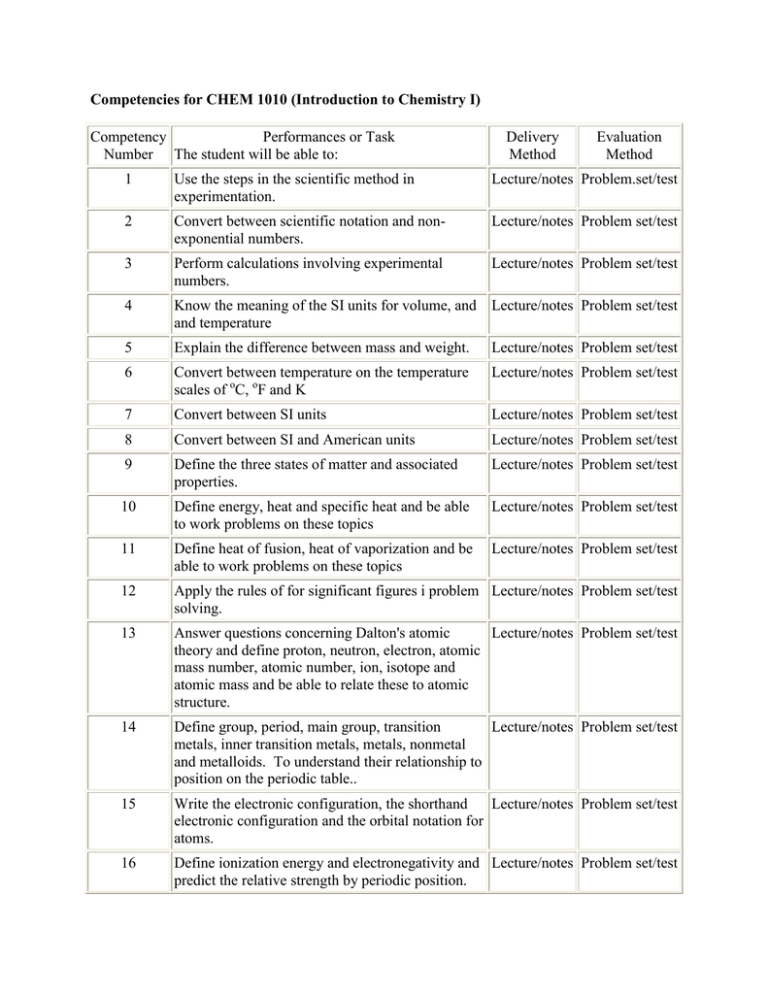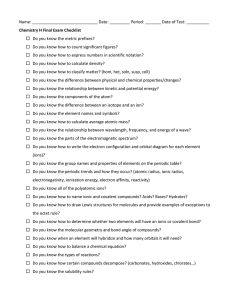Competencies for CHEM 1010 (Introduction to Chemistry I) Competency Performances or Task Delivery
advertisement

Competencies for CHEM 1010 (Introduction to Chemistry I) Competency Performances or Task Number The student will be able to: Delivery Method Evaluation Method 1 Use the steps in the scientific method in experimentation. Lecture/notes Problem.set/test 2 Convert between scientific notation and nonexponential numbers. Lecture/notes Problem set/test 3 Perform calculations involving experimental numbers. Lecture/notes Problem set/test 4 Know the meaning of the SI units for volume, and Lecture/notes Problem set/test and temperature 5 Explain the difference between mass and weight. Lecture/notes Problem set/test 6 Convert between temperature on the temperature scales of oC, oF and K Lecture/notes Problem set/test 7 Convert between SI units Lecture/notes Problem set/test 8 Convert between SI and American units Lecture/notes Problem set/test 9 Define the three states of matter and associated properties. Lecture/notes Problem set/test 10 Define energy, heat and specific heat and be able to work problems on these topics Lecture/notes Problem set/test 11 Define heat of fusion, heat of vaporization and be able to work problems on these topics Lecture/notes Problem set/test 12 Apply the rules of for significant figures i problem Lecture/notes Problem set/test solving. 13 Answer questions concerning Dalton's atomic Lecture/notes Problem set/test theory and define proton, neutron, electron, atomic mass number, atomic number, ion, isotope and atomic mass and be able to relate these to atomic structure. 14 Define group, period, main group, transition Lecture/notes Problem set/test metals, inner transition metals, metals, nonmetal and metalloids. To understand their relationship to position on the periodic table.. 15 Write the electronic configuration, the shorthand Lecture/notes Problem set/test electronic configuration and the orbital notation for atoms. 16 Define ionization energy and electronegativity and Lecture/notes Problem set/test predict the relative strength by periodic position. 17 Write Lewis structures for mono centered compounds and poly centered compounds. Lecture/notes Problem set/test 18 Draw shapes for molecules having up to four bonds per atom Lecture/notes Problem set/test 19 Determine the oxidation numbers in atoms, molecules and ions. Lecture/notes Problem set/test 20 Name binary covalent, binary ionic and polyatomic Lecture/notes Problem set/test ionic compounds. 21 Write the formula binary covalent, binary ionic and polyatomic ionic compounds. Lecture/notes Problem set/test 22 Calculate the molar mass of a compound. Lecture/notes Problem set/test 23 Know the difference between accuracy and precision. Lecture/notes Problem set/test 24 Perform mole concept problems Lecture/notes Problem set/test 25 Balance a chemical equation. Lecture/notes Problem set/test 26 Perform reaction stoichiometry problems. Lecture/notes Problem set/test 27 Perform percent yield problems Lecture/notes Problem set/test 28 Know the factors which induce a reaction to occur. Lecture/notes Problem set/test 29 Understand the concepts of electrolyte, activity series and solubility rules. Lecture/notes Problem set/test 30 Predict the products, balance the molecular equation, the total ionic equation, the net ionic equation and identify the spectator ions in single displacement reactions. Lecture/notes Problem set/test 31 Predict the products, balance the molecular equation, the total ionic equation, the net ionic equation and identify the spectator ions in double displacement reactions. Lecture/notes Problem set/test 32 Identify a redox reaction and identify the reactants Lecture/notes Problem set/test as oxidizing agents of reducing agents. 33 Identify and balance composition and decomposition reactions. 34 Differentiate between endothermic and exothermic Lecture/notes Problem set/test reactions. 35 Use the concepts of the kinetic theory of gases 36 Use pressure and understand its units and how it is Lecture/notes Problem set/test measured. Lecture/notes Problem set/test Lecture/notes Problem set/test 37 Use Boyle's law, Charles' law, Gay-Lussac's law and Graham's law to work problems dealing with gases. Lecture/notes Problem set/test 38 Define the intermolecular forces that exist between Lecture/notes Problem set/test compounds. 39 Understand the effect dipole-dipole interactions, hydrogen bonding and London dispersion forces have on gases, liquids and solids. 40 Describe the properties of liquids, i.e. evaporation, Lecture/notes Problem set/test condensation and boiling point. 41 Relate the shape of a molecule to its relative boiling point. Lecture/notes Problem set/test 42 Understand the meaning of allotropes, crystalline solids and amorphous solids. Lecture/notes Problem set/test 43 Differentiate between homogeneous mixtures and heterogeneous mixtures. Lecture/notes Problem set/test 44 Identify the parts of a solution and the characteristics of a solution. Lecture/notes Problem set/test 45 Define unsaturated, saturated and supersaturated. Lecture/notes Problem set/test 46 Relate solubility to "likeness," temperature and pressure. Lecture/notes Problem set/test 47 Work problems using the various units of concentration. Lecture/notes Problem set/test 48 Work dilution problems. Lecture/notes Problem set/test 49 Understand the dissolution process. Lecture/notes Problem set/test 50 Define colloids, suspensions and emulsions. Lecture/notes Problem set/test 51 Work problems dealing with colligative properties. Lecture/notes Problem set/test 52 Define kinetics and rate Lecture/notes Problem set/test 53 Define the two condition for and effective collision. Lecture/notes Problem set/test 54 Understand activation energy and energy diagrams Lecture/notes Problem set/test for endothermic reaction and exothermic reactions. 55 Know the affect of the reaction rate of reaction as Lecture/notes Problem set/test it refers to the nature of the reactants, the concentration , the temperature and the presence of a catalyst. 56 Know the difference between homogeneous and heterogeneous catalysts Lecture/notes Problem set/test Lecture/notes Problem set/test 57 Know the definition of reversible and irreversible reactions. Lecture/notes Problem set/test 58 Define dynamic equilibrium Lecture/notes Problem set/test 59 Define equilibrium constants and be able to write equilibrium expressions. Lecture/notes Problem set/test 60 Calculate equilibrium constants from equilibrium concentrations. Lecture/notes Problem set/test 61 Calculate equilibrium concentration from equilibrium constants. Lecture/notes Problem set/test 62 Know the affect of adding or removing a reactant or product on the position of equilibrium. Lecture/notes Problem set/test 63 Know the affect of changing the temperature o the Lecture/notes Problem set/test position of the equilibrium or the equilibrium constant for exothermic reactions and endothermic reactions. 64 Know the affect of changing the pressure on the position of the equilibrium. Lecture/notes Problem set/test 65 Know the affect of adding a catalyst on the position of the equilibrium or the equilibrium constant. Lecture/notes Problem set/test 66 Know the Arrhenius definition of acids and bases. Lecture/notes Problem set/test 67 Know the Brønsted-Lowry definition of acids and bases. Lecture/notes Problem set/test 68 Know how to use conjugate acid conjugate base theory Lecture/notes Problem set/test 69 Know the definition for amphoteric (and amphiprotic) species. Lecture/notes Problem set/test 70 Calculate the Ka from the equilibrium concentrations. Lecture/notes Problem set/test 71 Know the reactions of acids with metals, metal hydroxides, metal oxides, metal carbonates, metal hydrogen carbonates, ammonia and amines. Lecture/notes Problem set/test 72 Know the concept of auto ionization. Lecture/notes Problem set/test 73 Define the water ionization constant, Kw . Lecture/notes Problem set/test 74 Perform calculation using Kw and the hydronium and hydroxide concentrations. Lecture/notes Problem set/test 75 Know the definition of Ph and be able to perform pH calculations. Lecture/notes Problem set/test 76 Know how pH relates to acidity and basicity. Lecture/notes Problem set/test 77 Define indicators and how they are used. Lecture/notes Problem set/test 78 .Define pKa and be able to calculate it. Lecture/notes Problem set/test 79 Be able to predict the acidity, basicity or neutrality Lecture/notes Problem set/test of an aqueous salt solution 80 Define buffers and discuss the two types. Lecture/notes Problem set/test 81 Define the Henderson-Hasselbach equation. Lecture/notes Problem set/test 82 Determine the pH of an equilmolar mixture in a buffer solution. Lecture/notes Problem set/test 83 Determine the pH of an non equilmolar mixture in Lecture/notes Problem set/test a buffer solution. 84 Define buffer capacity. Lecture/notes Problem set/test 85 Understand the carbonate and phosphate buffer systems. Lecture/notes Problem set/test 86 Understand titration reactions and perform calculations based on them Lecture/notes Problem set/test 87 Define equivalence, equivalent weight and normality as it refers to titrations. Lecture/notes Problem set/test






